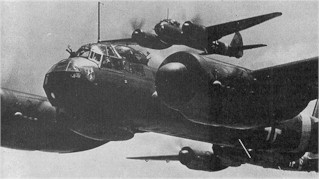|

|
The twin-engine Ju 88, produced in greater numbers than any other German bomber, was flown in the bomber, antitank, torpedo, day- and night-fighter, photo-reconnaissance, and training roles. Following a rapid development, the first Ju 88s entered Luftwaffe service early in 1939 as high-speed bombers. These planes participated in virtually all German aerial campaigns. They were used extensively in the Battle of Britain but suffered heavy losses in the daylight raids. Bomber and then specialized variants were produced into 1945. The Junker's bomber was developed in response to a 1935 Air Ministry requirement and the prototype Ju 88VI flew on Dec. 21, 1936, just eleven months after design work had commenced. Additional prototypes and pre-production models followed, with changes being made in engines and wingspan as well as other features. Variant development continued into 1945. Total production was about 9,000 bomber variants and about 6,000 non-bombers, a total of 14,676 production aircraft plus prototypes being built. The twin-engine aircraft had low-mounted wings with the radial-engine nacelles almost even with the nose. Variants had in-line and radial engines, with the main landing gear fully retracting into the nacelles. The Ju 88 featured a large glazed cockpit and nose, which afforded the pilot excellent visibility. Some of the fighter variants had a solid nose, with those aircraft retaining a bomb bay that could carry weapons or additional fuel; radar was fitted in the night fighters. The recon variants had fuel and cameras in the bomb bay and additional fuel in under-wing drop tanks. The Ju 88P antitank variant had a tank-busting cannon armament; the Ju 88P-1 variant had a 75 mm gun with a barrel that projected some six feet ahead of the aircraft; other Ju88P models had two 37 mm cannon.
|